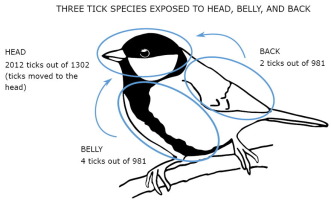当前位置:
X-MOL 学术
›
Int. J. Parasitol.
›
论文详情
Our official English website, www.x-mol.net, welcomes your
feedback! (Note: you will need to create a separate account there.)
Experimental study of micro-habitat selection by ixodid ticks feeding on avian hosts.
International Journal for Parasitology ( IF 3.7 ) Pub Date : 2019-11-14 , DOI: 10.1016/j.ijpara.2019.09.003 Gerardo Fracasso 1 , Erik Matthysen 1 , André A Dhondt 2 , Dieter Heylen 3
International Journal for Parasitology ( IF 3.7 ) Pub Date : 2019-11-14 , DOI: 10.1016/j.ijpara.2019.09.003 Gerardo Fracasso 1 , Erik Matthysen 1 , André A Dhondt 2 , Dieter Heylen 3
Affiliation

|
Mechanisms of on-host habitat selection of parasites are important to the understanding of host-parasite interactions and evolution. To this end, it is important to separate the factors driving parasite micro-habitat selection from those resulting from host anti-parasite behaviour. We experimentally investigated whether tick infestation patterns on songbirds are the result of an active choice by the ticks themselves, or the outcome of songbird grooming behaviour. Attachment patterns of three ixodid tick species with different ecologies and host specificities were studied on avian hosts. Ixodes arboricola, Ixodes ricinus and Ixodes frontalis were put on the head, belly and back of adult great tits (Parus major) and adult domestic canaries (Serinus canaria domestica) which were either restricted or not in their grooming capabilities. Without exception, ticks were eventually found on a bird's head. When we gave ticks full opportunities to attach on other body parts - in the absence of host grooming - they showed lower attachment success. Moreover, ticks moved from these other body parts to the host's head when given the opportunity. This study provides evidence that the commonly observed pattern of ticks feeding on songbirds' heads is the result of an adaptive behavioural strategy. Experimental data on a novel host species, the domestic canary, and a consistent number of published field observations, strongly support this hypothesis. We address some proximate and ultimate causes that may explain parasite preference for this body part in songbirds. The link found between parasite micro-habitat preference and host anti-parasite behaviour provides further insight into the mechanisms driving ectoparasite aggregation, which is important for the population dynamics of hosts, ectoparasites and the micro-pathogens for which they are vectors.
中文翻译:

以鸟类为食的odi类odi的微生境选择的实验研究。
寄主对寄生虫的栖息地选择机制对于理解寄主-寄生虫的相互作用和进化很重要。为此,重要的是将驱动寄生虫微栖息地选择的因素与宿主抗寄生虫行为产生的因素分开。我们通过实验研究了鸣禽上tick虱侵扰模式是are本身主动选择的结果,还是鸣禽修饰行为的结果。在鸟类寄主上研究了三种具有不同生态和寄主特异性的ixodid壁虱物种的附着模式。将成虫,成虫和额额虫放在成年大山雀(Parus major)和成年家养金丝雀(Serinus canaria domestica)的头,腹部和背部上,它们的梳毛能力受到限制或没有受到限制。无一例外,最终在鸟的头上发现了tick虫。当我们给予tick虫充分的机会附着在其他身体部位上时(在没有宿主修饰的情况下),它们显示出较低的附着成功率。此外,如果有机会,tick虫会从其他身体部位移到宿主的头部。这项研究提供的证据表明,通常观察到的以鸣鸟的头为食的tick的模式是适应性行为策略的结果。关于新型寄主物种,家养金丝雀的实验数据以及已发表的大量实地观察资料,强烈支持了这一假说。我们解决了一些直接的和最终的原因,这些原因可能解释了鸣禽对这一身体部位的寄生虫偏爱。
更新日期:2019-11-14
中文翻译:

以鸟类为食的odi类odi的微生境选择的实验研究。
寄主对寄生虫的栖息地选择机制对于理解寄主-寄生虫的相互作用和进化很重要。为此,重要的是将驱动寄生虫微栖息地选择的因素与宿主抗寄生虫行为产生的因素分开。我们通过实验研究了鸣禽上tick虱侵扰模式是are本身主动选择的结果,还是鸣禽修饰行为的结果。在鸟类寄主上研究了三种具有不同生态和寄主特异性的ixodid壁虱物种的附着模式。将成虫,成虫和额额虫放在成年大山雀(Parus major)和成年家养金丝雀(Serinus canaria domestica)的头,腹部和背部上,它们的梳毛能力受到限制或没有受到限制。无一例外,最终在鸟的头上发现了tick虫。当我们给予tick虫充分的机会附着在其他身体部位上时(在没有宿主修饰的情况下),它们显示出较低的附着成功率。此外,如果有机会,tick虫会从其他身体部位移到宿主的头部。这项研究提供的证据表明,通常观察到的以鸣鸟的头为食的tick的模式是适应性行为策略的结果。关于新型寄主物种,家养金丝雀的实验数据以及已发表的大量实地观察资料,强烈支持了这一假说。我们解决了一些直接的和最终的原因,这些原因可能解释了鸣禽对这一身体部位的寄生虫偏爱。











































 京公网安备 11010802027423号
京公网安备 11010802027423号